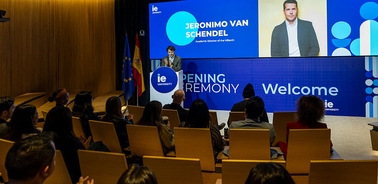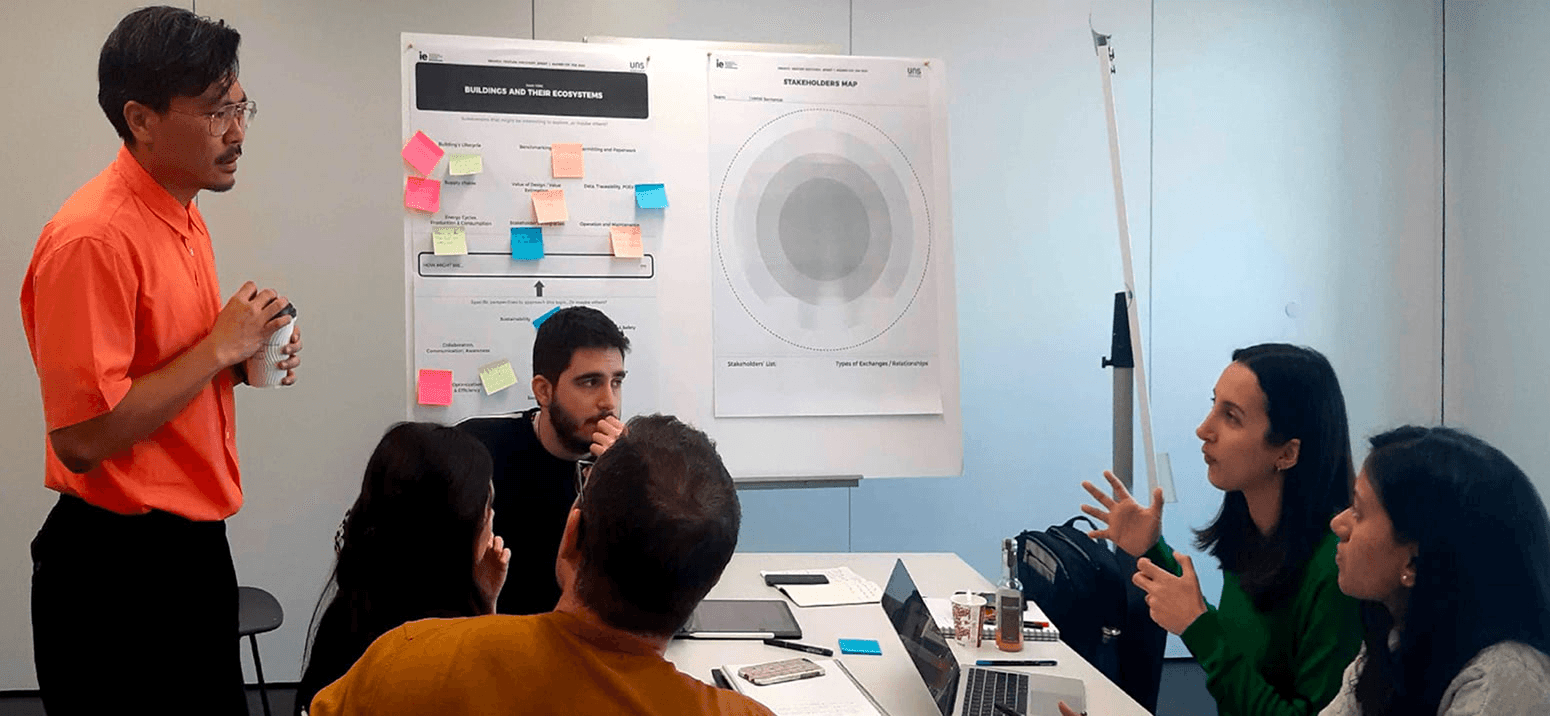IE University's Master in Business for Architecture and Design Grows Its Global Impact

Jerónimo van Schendel, Director of the program, reflects on a transformative journey centered on innovation, sustainability, and strategic partnerships—with UNS playing a key role.
Founded 14 years ago, the IE Master in Business for Architecture and Design connects the creativity of built-environment professionals with the business acumen needed to drive meaningful change. Its mission is supported by a unique ecosystem of faculty and companies, featuring a partnership with UNS, led by Founder and Principal Architect Ben van Berkel and Associate Design Director Ren Yee. Both are directly involved in mentoring design entrepreneurship projects at the program's Venture Lab, which helps students tackle real-world challenges.
Emphasizing innovation, entrepreneurship, and technology—with AI integration and a strong commitment to sustainability—the program’s curriculum offers students firsthand insights into the business side of design through conversations, lectures, and visits in the Netherlands (Amsterdam, Rotterdam, Delft and Eindhoven) and the metropolitan area of Madrid. Alumni are already making an impact globally, expanding the role of architects and designers into fields such as design innovation within creative companies, real estate, cities’ development, urbanism, and technology for the built environment.
As the latest cohort of the Master in Business for Architecture and Design officially kicked off at the end of March, we spoke with Jerónimo van Schendel and Ren Yee about the future of the program and its evolving role in shaping the built environment.
What challenges did you face in establishing this program, and how did you overcome them?
Jerónimo van Schendel: The ecosystem of unique companies surrounding the program, which allows students to learn from professionals across diverse industries and cultures, is one of its key strengths. Maintaining this level of excellence requires continuous effort and evolution. Equally challenging is recruiting professors who are experienced professionals, skilled educators, and passionate about innovation and research, blending expertise in design, engineering, construction, business, and entrepreneurship. For instance, Helen Logan, an architect and business expert, contributed to expand the firm Allies & Morrisson as Managing Partner, from 10 employees to over 350, making it the UK’s sixth-largest architecture practice—rare and invaluable profiles like hers are central to the program's success. Or, on the Architectural Technology side, Roberto Molinos, founder of Modelical, has built one of Europe's leading BIM technology and innovation firms delivering projects such as the BIM strategy for the Sagrada Familia in Barcelona and the Qatar World Cup stadiums.
How do you use AI in the Master in Business for Architecture and Design?
Jerónimo van Schendel: We integrate AI into the curriculum gradually, starting with an exploration of the tech landscape and progressing to applications in business and design, such as streamlining workflows, calculating carbon footprints, and enhancing sustainability.
"We also promote open discussions on responsible AI use, including tools like ChatGPT, preparing students for an AI-driven future."
Jerónimo van Schendel, Director of the Master in Business for Architecture and Design
IE University also provides specialized AI training for faculty members, enabling them to stay at the forefront of innovation while envisioning AI’s long-term potential beyond the current "hype". This ensures a lasting impact on how our students perceive and apply AI in business.
In the Venture Lab, students apply AI to tackle real-world challenges. A notable example is MODO—a startup by Master in Business for Architecture and Design alumni—which won a global Sustainability Award at IE Venture Day Madrid 2023 for its AI-driven housing configuration system using prefabricated elements and local resources.
What are the program's most significant achievements? Which success stories from your alumni network would you highlight?
Jerónimo van Schendel: Our alumni community exceeds 350 members from over 30 countries and includes leaders in architecture and design worldwide. For example, Nigerian alumna Tosin Oshinowo is one of her country’s top architects, participating in prestigious events like the Venice Biennale and recognized in the RIBA International Awards. Dana Nayef founded the Middle East’s first marketplace for short-term retail spaces. Elvira Conejero co-founded Labit Group, a leader in retail and workspace design in Madrid. Other alumni have excelled at the corporate level like María Mahmmoud, who has led interior design teams at WeWork LATAM and contributed to the spatial planning of two FIFA World Cups.
How has the Venture Lab influenced the development of innovative projects within the program? What role does UNS play in this process?
Jerónimo van Schendel: The Venture Lab is a long-term, mentored workshop from the first session at UN in Amsterdam to graduation, where student teams transform problems they’re passionate about into business opportunities and ventures related to the built environment. By the program’s end, students produce a business plan, prototype, pitch deck, and presentation of their ventures. While academic, the lab mirrors an incubation experience, preparing ventures for potential commercial testing post-graduation. Collaborating with UNS, their Associate Design Director Ren Yee and senior strategists guide our students in solving problems and delivering impactful, boundary-pushing solutions for the industry.
 Ren Yee, Associate Design Director at UNS, during a Venture Lab session with the MBArch's students.
Ren Yee, Associate Design Director at UNS, during a Venture Lab session with the MBArch's students. How does the Venture Lab align with UNS's goals, and why is it of interest to the firm?
Ren Yee: UNS has always been at the forefront of integrating innovation into our architectural and business practices. The Venture Lab on our Madrid campus offers a platform that resonates with our commitment to tackling pressing societal and environmental challenges through innovation in technology, design and business. A good example of this alignment is seen in projects that emerge from the Lab, such as using digital technology to reimagine urban spaces for enhanced food security and community engagement. These projects not only address key urban challenges but also push the boundaries of traditional architectural practice, making the Venture Lab an exciting collaborator in our continuous effort to shape the future of our cities and our profession.
What emerging trends have you observed among the ventures developed at the Venture Lab over the years?
Ren Yee: Digital technology, particularly AI, has become increasingly integral to the ventures at the Venture Lab. These projects are exploring how AI can address a range of challenges and spark important conversations about ethics and ownership in new technology applications. This reflects a growing recognition of the role that digital tools play in shaping innovative architectural solutions.
Additionally, there's a strong focus on circularity, with students actively applying principles of the circular economy to develop sustainable solutions. This proactive approach is preparing them to lead in environmental sustainability, showing a significant shift towards responsible and impactful design practices."
Which Venture Lab project made the biggest impression on you, and why did it leave a lasting impact?
Ren Yee: One memorable venture tackled the challenge of affordable housing not through architectural design but by innovating within financial models. The students proposed alternative financing and ownership structures that could significantly alter how housing markets function, making them more accessible and equitable. This project stood out because it showcased the powerful impact of cross-disciplinary thinking, where financial innovation meets societal needs. The approach was not just about building cheaper houses but rethinking the economics of housing itself, which could lead to sustainable changes in how we address global housing crises.
Are there any stories of Venture Labs that ended up as real businesses or evolved into something more?
Jerónimo van Schendel: The true impact of our Venture Labs lies in the people involved. Over 45% of our students pursue entrepreneurial roles after the program, whether in startups, companies, or family businesses. The goal of the Venture Lab is not only to help students develop a single business idea but to equip them with the skills to thrive in any business opportunity they encounter. And in that, they excel. Our students have gone on to establish design studios and brands across all continents, from Europe to the Middle East, Africa, Asia, and Latam.
As for academic ventures, while some remain on course, many evolve as team members in different countries seize opportunities in their local markets, leading to independent entrepreneurial paths. The program provides a risk-free environment where students, surrounded by talented peers, refine their business ideas, making the experience truly invaluable.
How do you think graduates from the program are shaping the architecture and design industry on a global scale?
Jerónimo van Schendel: Traditionally, architecture has focused on spatial considerations, but our program highlights space as a strategic business tool, linking it to outcomes such as brand identity, workplace productivity, and urban planning. As a result, graduates now move beyond conventional design, spearheading tech-based ventures—including real estate platforms, material marketplaces, and supply chain software—and even managing major global events like the World Cup. Given architects’ ability to coordinate complex processes, they are uniquely positioned to lead these interdisciplinary efforts.
Who is this program designed for in terms of student background and interests?
Jerónimo van Schendel: While most of our students are professionals with 5–10 years of experience in architecture, engineering, design, or related fields who aspire to leadership or innovation in their industries, we also welcome participants with 3 to over 15 years of professional experience who may be balancing work, family, and leadership roles. Our cohort typically includes students from 15 to 18 different nationalities, which enriches the program and creates a truly global learning environment.
***
Jerónimo van Schendel is an architect and entrepreneur known for his innovative contributions to architecture and digital transformation in the construction industry. He has led architecture projects and competitions for public buildings in Spain, China and LATAM, working at offices like Abalos+Sentkiewicz, among others. He co-founded Bildia, the first Spanish platform that uses AI to optimize procurement in construction, and serves as the Director of the Master in Business for Architecture and Design at IE University. He also mentors startups in the construction and sustainability sectors at IE and the Plug and Play Tech Center, promoting technological advancements and entrepreneurship.
Ben van Berkel, Founder and Principal Architect of UNS, is renowned for his cutting-edge design, dedication to sustainability, and deep understanding of the impact the built environment has on health and wellbeing. His unconventional approach, which investigates the interconnections between culture and commerce, consistently breaks new creative ground and works to solve real world problems. He brings creative and visionary thinking to an expanding set of expertises within the fields of health, sustainability, technology and economics, delivering evermore value to clients and partners. Van Berkel is Chair of the International Committee of Experts of IE School of Architecture and Design and Thesis Chair for the IE MArch program.
Ren Yee is an Associate Director at UNS where his expertise goes beyond traditional design to include health, economics, and technology consultancy. His commitment to user-centric, empathetic design merges digital and physical spaces to create environments that are innovative and focused on human needs. This approach not only sets new standards in the industry but also redefines how design can enhance human experiences.